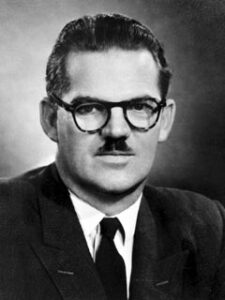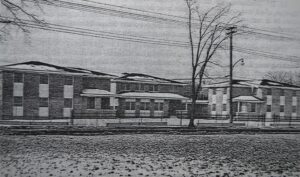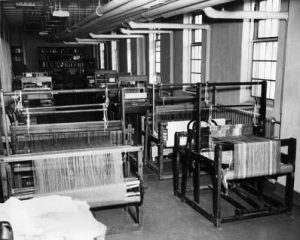Verdun / Douglas
Name(s) of Institution:
Verdun Protestant Hospital for the Insane (1881)
Verdun Protestant Hospital (renamed 1925)
Douglas Hospital (renamed 1965)
Douglas Mental Health University Institute (renamed 2006)
Opened:
1881
Location:
Verdun (now annexed to Montréal)
Period of Deinstitutionalization:
1947–1972
Patient Demographic:
| YEAR | TOTAL | YEAR | TOTAL |
| 1890 | 139 | 1942 | 1479 |
| 1899 | 354 | 1951 | 1621 |
| 1910 | 610 | 1960 | 1530-1580* |
| 1936 | 1200 |
* In 1960, there were between 1,530 and 1,580 patients hospitalized, 1,114 of whom left the hospital during that year.
Deinstitutionalization:

Evolving separately from French institutions, which tended to fall to the responsibility of church-run organizations, the Verdun Protestant Hospital (VPH) was influenced by American psychiatry and subsequently was at the forefront of the psychiatric revolution that took place in Quebec in the 1960s and 1970s. Signs of de-institutionalization began as early as the 1920s with hospital social workers conducting biweekly visits to conditionally discharged patients. In 1947, VPH began experimenting with group and occupational therapy as well as “aftercare services, home visits, foster care, and transitional housing.” In 1955, as a result of an inspection by the American Psychiatric Association at the hospital board’s request, programs were instituted to improve patient hygiene and family care, and an outpatient department and aftercare clinic were also introduced. These initiatives were accompanied by increased patient freedoms, including weekend passes and unsupervised city outings.
The lengthy timeline of de-institutionalization at Verdun meant that the overall process was much less abrupt than at francophone hospitals such as Saint-Jean-de-Dieu and Saint-Michel-Archange. By 1962, the VPH was outpacing similar francophone institutions in the province with an estimated 75 percent of its resources being dedicated to patient rehabilitation. In 1965, the hospital changed its name to Douglas Hospital to honour James Douglas and reflect the religious diversity of the patient population. In-patient population peaked in 1966 at 1,840 patients but, reflective of the move to de-institutionalization, by 1970, the institution had more outpatients than in-patients.
Transinstitutionalization:
In 1956, a family care program was initiated at VPH. Patients whose condition was not considered serious enough to need hospitalization, but who still required therapeutic monitoring, were placed by social services in supervised therapeutic residential facilities. At home, patients received regular visits from a social worker and a physician evaluated their status monthly. Approximately 250 patients lived in these therapeutic residences or in foster care during this period.
In 1961, a grant allowed the construction of a residential social rehabilitation centre. Commonly known as The 7075, it consisted of a transitional residence for patients to facilitate their reintegration into the community.

Between 1961 and 1965, the VPH aftercare clinic grew to twice its capacity with more than 1,400 patients on record. The clinic also evaluated and treated people who had never been hospitalized at VPH. This clinic later became the Community Mental Health Centre. Another outpatient service, the day centre begun in 1965 and accommodated an average of 115 people daily.
The hospital also established a pre- and post-hospitalization home visit program in 1966. A team consisting of a psychiatrist, a social worker, and a public health nurse made visits to people with mental health issues to make an assessment and develop a treatment plan. By the end of 1967, more than 200 visits had taken place.
In 1973, the hospital set up the LaSalle Clinic, an outpatient community mental health clinic located outside the confines of the hospital.
Work Therapy into Occupational Therapy:

The pattern of early reforms at Verdun was exemplified in the early development of occupational therapy, which was initiated in 1918. At first reserved for hospitalized soldiers, the program established a carpentry workshop and, two years later, basketry production. By 1926, the occupational therapy department, under the direction of Mary Caton, was booming and involved more than 400 patients.
Industrial therapy was established in 1959 under the direction of Jenny May Handford, director of occupational therapy at VPH. Patients continued to work in traditional settings like the laundry, kitchen, farm, and tailor shop, but also in new institutional locations such as the locker room, paint shop, carwash, laboratories, X-ray rooms, pharmacy, and hair salon.
The Bédard Commission reported in 1962 that at VPH, “nearly 50 percent of patients … regularly participate in activities, either occupational therapy or workshops where the following trades are taught by qualified instructors: carpentry, painting, farm work, office work, leather work, ceramics, weaving, cooking and laundry, and finally care for the sick …. There is a formal recreation program involving 90 percent of patients, [which] is run by qualified personnel of the department of occupational therapy.”

In 1966, the occupational therapy department was housed in a new building, the Mary Caton Centre, with about half the patients considered “active patients” and more than 300 participating in occupational therapy programs. The industrial therapy of the period aimed to recreate the dynamics of regular employment in order to prepare patients for waged work when they left the hospital.
Also in 1966, the hospital inaugurated the Roberts Recreation Centre, which had a bowling alley, a gym, and a swimming pool program. A behavioural therapy unit created the following year later became a training centre for McGill University Behavioural Therapy students. In 1969, a drawing and painting therapy program was initiated and later extended to music and creative writing.
Patient into Person:
In 1955, a “Council of Patients” was established to include patients in the hospital’s decision making. During the same year, the Outlook, a quarterly journal written and edited by patients, began distribution.
In 1958, the Forward Club was founded by the VPH’s psychiatric patients. Renamed the Forward House Inc. in 1962, this group allowed former patients to build relationships and provide mutual support.
In 1966, a program of “remotivation” therapy was introduced at VPH. The technique consisted of “patients meeting in groups with the remotivator for an hour or so to discuss topics of current interest, to stimulate them, and to promote the functioning of the healthy part of their personalities unaffected by their illnesses.”
Staffing in the Deinstitutionalization Era:
Before 1945, the health care staff at VPH was only composed of general practitioners, nurses, and occupational therapists. In 1945, the first psychologist was hired. Six years later, the hospital had three psychologists and six psychiatrists.

In 1946, the hospital was accredited to train residents in psychiatry who had undertaken specialized coursework at McGill University. In 1965, the hospital was able to accommodate twenty-three such residents.
In 1951, the nursing students of Queen Elizabeth and Reddy Memorial Hospitals began internships at VPH. The following year, nursing programs at St. Mary’s, Jewish General, and Montreal General Hospitals were affiliated. In 1967, more than 250 nursing students completed their internships at Douglas Hospital.
During the 1960s, other professional and administrative staff of the hospital also gradually increased.
Sources:
Bédard, Dominique, et al. Rapport de la Commission d’études des hôpitaux psychiatriques. Quebec City: Health Minister, 1962.
https://www.msss.gouv.qc.ca/sujets/prob_sante/sante_mentale/download.php?f=f8571bc8ed9d19dc9a35c6bcdc18d293.
Boudreau, Françoise. De l’asile à la santé mentale: les soins psychiatriques : histoire et institutions. 2e édition. Montréal: Éditions Saint-Martin, [1984] 2003.
Cahn, Charles H. Hôpital Douglas : 100 ans d’histoire et de progrès / Douglas Hospital: 100 Years of History and Progress. Verdun: Douglas Hospital Centre, 1981.
Fleury, Marie-Josée, et Guy Grenier. «Historique et enjeux du système de santé mentale québécois.» Ruptures, revue transdisciplinaire en santé vol. 10, n° 1 (2004): 21–38.
Lecomte, Yves. «De la dynamique des politiques de désinstitutionnalisation au Québec» Santé mentale au Québec vol. 22, n° 2 (1997): 7–24.
L’Hôpital Douglas 125e. https://125.douglas.qc.ca/index.php.
L’Institut Douglas. « Historique. » L’Institut universitaire en santé mentale Douglas. https://www.douglas.qc.ca.
Wallot, Hubert. La danse du fou entre la compassion et l’oubli : Survol de l’histoire organisationnelle de la prise en charge de la folie au Québec depuis les origines jusqu’à nos jours. Beauport: Beauport Publications MNH, 1998.


